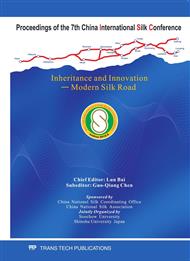[1]
J.R.E. Rossitch, D.E. Bullard, W.J. Oakes: Childs Nerv Syst Vol. 3(1987), p.375.
Google Scholar
[2]
T.N. Salthouse, B.F. Matlaga, M.H. Wykoff: Am J Ophthalmol Vol. 84(1977), p.224.
Google Scholar
[3]
T. Arai, G. Freddi, R. Innocenti, M. Tsukada: J Appl Polym Sci Vol. 91 (2004), p.2383.
Google Scholar
[4]
M. Z. Li, M. Ogiso, N. Minoura: Biomaterials Vol. 24 (2003), p.357.
Google Scholar
[5]
N. Minoura, M. Tsukada, M. Nagura: Biomaterials Vol. 11 (1990), p.430.
Google Scholar
[6]
K.H. Lam, A. J. Nijenhuis, H. Bartels, A.R. Postema, M.F. Jonkman, A.J. Pennings, P. Nieuwenhuis: J Appl. biomater Vol. 6 (1995), p.191.
DOI: 10.1002/jab.770060308
Google Scholar
[7]
A. Takayuki, F. Giuliano, I. Riccardo: Journal of Applied Polymer Science Vol. 91 (2004), p.2383.
Google Scholar
[8]
D. Greenwald, S. Shumway, P. Albear, L.J. Gottlieb: Surg Res Vol. 56 (1994), p.372.
Google Scholar
[9]
R. Kino, T. Ikoma, S. Yunoki, A. Monkawa, A. Matsuda, G. Kagata, T. Asakura, M. Munekata, J. Tanaka: Key Engineering Materials Vol. 309-311 (2006), p.1169.
DOI: 10.4028/www.scientific.net/kem.309-311.1169
Google Scholar
[10]
A. Apap-Bologna, A. Webster, F. Raitt, G. Kemp: Biochim. Biophys. Acta Vol. 995 (1989), p.70.
Google Scholar
[11]
H. Lilie, W. Haehnel, R. Rudolph, U. Baumann: FEBS Lett. Vol. 4 (2000), p.173.
Google Scholar
[12]
K.A. McClintock, G. S. Shaw: J. Biol. Chem. Vol. 17 (2003), p.6251.
Google Scholar
[13]
P. Zhou, X. Xie, D.P. Knight X.H. Zong: Biochemistry, Vol. 43 (2004), p.11302.
Google Scholar
[14]
G.Y. Li, P. Zhou, Y. J. Sun, W. H. Yao, Y. Mi, H.Y. Yoa, Z.Z. Shao, T.Y. Yu: Chem J Chin Univ Vol. 2 (2001), p.860.
Google Scholar
[15]
T. Asakura, H. Suzuki, Y. Watanabe: Macromolecules Vol. 16 (1983), p.1024.
Google Scholar
[16]
T. Asakura, Y. Watanabe, T. Itoh: Macromolecules Vol. 17 (1984), p.2421.
Google Scholar
[17]
C. Wong, E. Bini , J. Huang, D.L. Kaplan: Applied Physics A: Materials Science & Processing Vol. 82 (2006), p.193.
Google Scholar
[18]
P. Taddei, P. Monti: Biopolymers Vol. 78(2007), p.249.
Google Scholar
[19]
T. Lefevre, M.E. Rousseau, M. Pezolet: Biophysical journal Vol. 92(2007), p.2885.
Google Scholar


